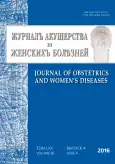Evaluation of significant bacteriuria in pregnant women using quantitative real-time PCR
- Authors: Khusnutdinova T.A.1, Shipitsina E.V1, Savochkina Y.A.2, Timoshina O.Y.2, Rybina E.V.1, Gushchin A.E.2, Savicheva A.M.1
-
Affiliations:
- D. O. Ott Research Institute of Obstetrics and Gynecology, RAMS
- Central Research Institute for Epidemiology
- Issue: Vol 65, No 4 (2016)
- Pages: 50-56
- Section: Articles
- URL: https://journals.rcsi.science/jowd/article/view/5822
- DOI: https://doi.org/10.17816/JOWD65450-56
- ID: 5822
Cite item
Full Text
Abstract
Introduction. Urinary tract infections are the most common infections in obstetrics and gynecology. Bacteriological method to investigate urine is laborious and time-consuming, therefore development of accurate and rapid methods for the detection of significant bacteriuria is important.
Objective. Evaluation of quantitative real-time PCR based approach for the detection of significant bacteriuria in pregnant women.
Material and methods. A retrospective investigation of mid-stream urine samples obtained from pregnant women was performed. Urine culture was performed using quantitative method, and a case was considered as significant bacteriuria if ≥ 105 CFU/ml were detected. Urine samples were analyzed for main uropathogens / groups of uropathogens using quantitative multiplex real-time PCR. Diagnostic characteristics of PCR were computed relative to the results of urine culture.
Results. In total, 896 urine samples were tested. Of them, significant bacteriuria was found in 28 cases (3%). The frequency of detection of Escherichia coli was 50%, Enterococcus spp. — 25%, Klebsiella spp. — 7%, Proteus spp. and S. saprophyticus 4% each, Streptococcus spp. — 14%. Sensitivity and specificity of the detection of significant bacteriuria using quantitative real-time PCR for the majority of bacterial species / groups were 99% to 100%. Sensitivity and specificity of the quantitative real-time PCR based method were 96% and 98%, respectively.
Conclusions. Prevalence of significant bacteriuria among pregnant women is 3%. Half of the uropathogens isolated from pregnant women with bacteriuria are E. coli. Sensitivity and specificity of quantitative PCR for the detection of significant bacteriuria are 96% and 98%, respectively.
Full Text
##article.viewOnOriginalSite##About the authors
Tatyana A. Khusnutdinova
D. O. Ott Research Institute of Obstetrics and Gynecology, RAMS
Author for correspondence.
Email: iagmail@ott.ru
Researcher, Laboratory of Microbiology Russian Federation
Elena V Shipitsina
D. O. Ott Research Institute of Obstetrics and Gynecology, RAMS
Email: iagmail@ott.ru
PhD, Senior Researcher, Laboratory of Microbiology Russian Federation
Yulia A. Savochkina
Central Research Institute for Epidemiology
Email: aguschn@pcr.ru
PhD, Senior Researcher, Laboratory for Molecular Diagnostic and Epidemiology of Reproductive Tract Infections Russian Federation
Olga Yu. Timoshina
Central Research Institute for Epidemiology
Email: aguschn@pcr.ru
Reseach Assistant, Laboratory for Molecular Diagnostic and Epidemiology of Reproductive Tract Infections Russian Federation
Elena V. Rybina
D. O. Ott Research Institute of Obstetrics and Gynecology, RAMS
Email: iagmail@ott.ru
Bacteriologist, Laboratory of Microbiology Russian Federation
Alexander E. Gushchin
Central Research Institute for Epidemiology
Email: aguschn@pcr.ru
PhD, Head of the Laboratory for Molecular Diagnostic and Epidemiology of Reproductive Tract Infections Russian Federation
Alevtina M. Savicheva
D. O. Ott Research Institute of Obstetrics and Gynecology, RAMS
Email: savitcheva@mail.ru
MD, Professor, Head of Laboratory of Microbiology Russian Federation
References
- Лопаткин Н.А., Мартов А.Г. Состояние и перспективы развития урологической помощи в Российской Федерации // Материалы Х съезда урологов (отчет). — M., 2002. — C. 1–3 [Lopatkin NA, Martov AG. Sostoyanie i perspektivy razvitiya urologicheskoi pomoshchi v Rossiiskoi Federatsii. (Conference proceedings). Moscow; 2002:1-3. (In Russ).]
- Schappert SM. Ambulatory care visits to physician offices, hospital outpatient departments, and emergency departments. United States, 1997. Vital Health Stat 13. 1999;143(i-iv):1-39.
- Nicolle L, Anderson PA, Conly J, et al. Uncomplicated urinary tract infection in women. Current practice and the effect of antibiotic resistance on empiric treatment. Can Fam Physician. 2006;52:612-8. doi: 10.1016/j.ucl.2007.09.004.
- Nicolle LE. Uncomplicated urinary tract infection in adults including uncomplicated pyelonephritis. Urol Clin North Am. 2008;35(1):1-12.
- Gilstrap LC 3rd, Cunningham FG, Whalley PJ. Acute pyelonephritis in pregnancy: an anterospective study. Obstet Gynecol. 1981;57(4):409-413.
- Romero R, Oyarzun E, Mazor M, et al. Metaanalysis of the relationship between asymptomatic bacteriuria and preterm delivery/low birthweight. Obstet Gynecol. 1989;73(4):576-82.
- Flores-Mireles AL, Walker JN, Caparon M, et al. Urinary tract infections: epidemiology, mechanisms of infection and treatment options. Nat Rev Microbiol. 2015;13(5):269-84. doi: 10.1038/nrmicro3432.
- Pezzlo M. Laboratory Diagnosis of Urinary Tract Infections: Guidelines, Challenges, and Innovations. Clinical Microbiology Newsletter. 2014;36(12):87-93. doi: 10.1016/j.clinmicnews.2014.05.003.
- Bachman JW, Heise RH, Naessens JM, et al.
- A study of various tests to detect asymptomatic urinary tract infections in an obstetric population. JAMA. 1993;270(16):1971-1974. doi: 10.1001/jama.1993.03510160089035.
- Demilie T, Beyene G, Melaku S, et al. Diagnostic accuracy of rapid urine dipstick test to predict urinary tract infection among pregnant women in Felege Hiwot Referral Hospital, Bahir Dar, North West Ethiopia. BMC Res Notes. 2014;7:481. doi: 10.1186/1756–0500–7–481.
- Mignini L, Carroli G, Abalos E, et al. Accuracy of diagnostic tests to detect asymptomatic bacteriuria during pregnancy. Obstet Gynecol. 2009;113(2Pt1):346-52. doi: 10.1097/AOG.0b013e318194f109.
- Pfaller MA, Koontz FP. Laboratory evaluation of leukocyte esterase and nitrite tests for the detection of bacteriuria. J Clin Microbiol. 1985;21(5):840-842.
- Grabe M, Bartoletti R., Bjerklund-Johansen TE et al. Guidelines on urological infections. European Association of Urology. 2015.
- Палагин И.С., Сухорукова М.В., Дехнич А.В., и др. Современное состояние антибиотикорезистентности возбудителей внебольничных инфекций мочевых путей в России: результаты исследования «ДАРМИС» (2010–2011) // Клин. микробиол. антимикроб. химиотер. — 2012. — Т. 14, № 4. — С. 280–302. [Palagin IS, Sukhorukova MV, Dekhnich AV i dr. Current State of Antibiotic Resistance of Pathogens Causing Community-Acquired Urinary Tract Infections in Russia: DARMIS Study (2010–2011). Klin mikrobiol antimikrob chimioter. 2012;14(4):280-302.
- (In Russ).]
- Zee A, Roorda L, Bosman G, et al. Molecular diagnosis of urinary tract infections by semi-quantitative detection of uropathogens in a routine clinical hospital setting. PLoS One. 2016;11(3):e0150755. doi: 10.1371/journal.pone.0150755.
Supplementary files







